Unit 3 Safety 单元知识点课件(共100张PPT)
文档属性
| 名称 | Unit 3 Safety 单元知识点课件(共100张PPT) | 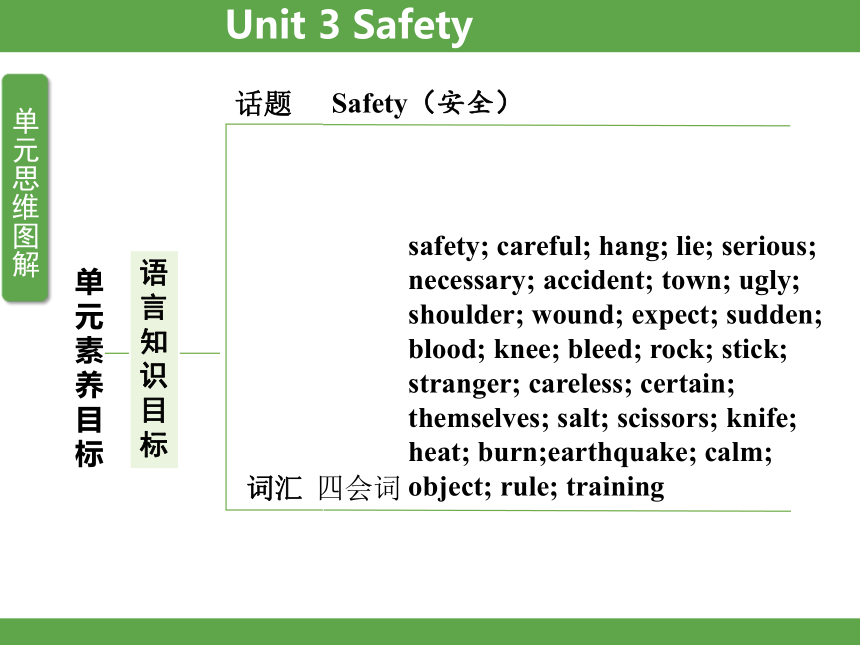 | |
| 格式 | pptx | ||
| 文件大小 | 937.3KB | ||
| 资源类型 | 教案 | ||
| 版本资源 | 冀教版 | ||
| 科目 | 英语 | ||
| 更新时间 | 2024-07-03 22:39:14 | ||
图片预览

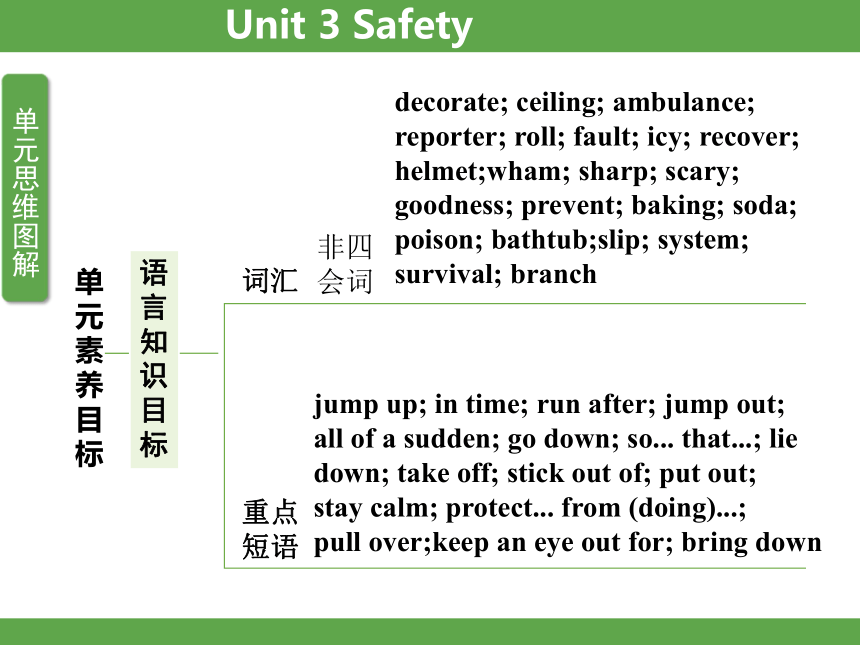

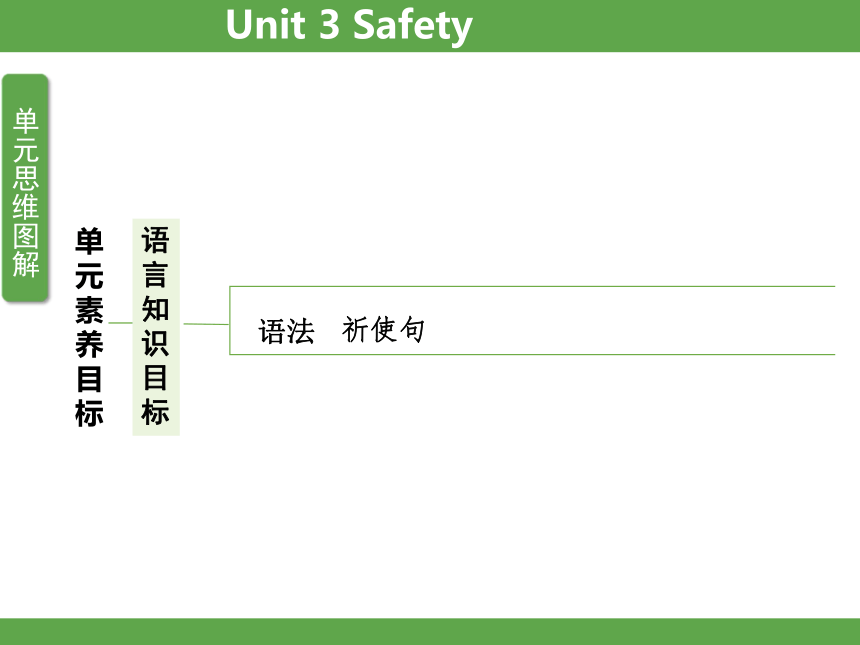

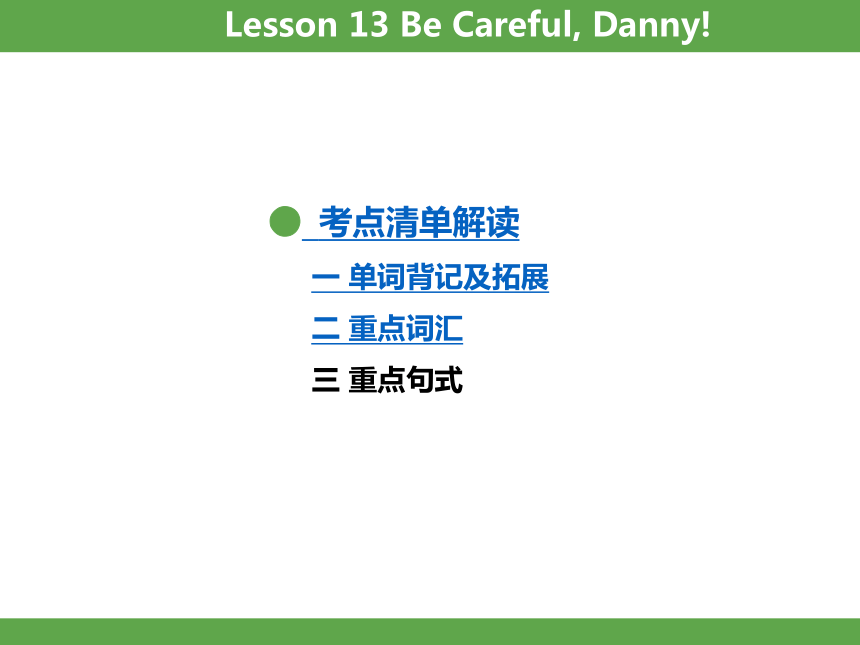

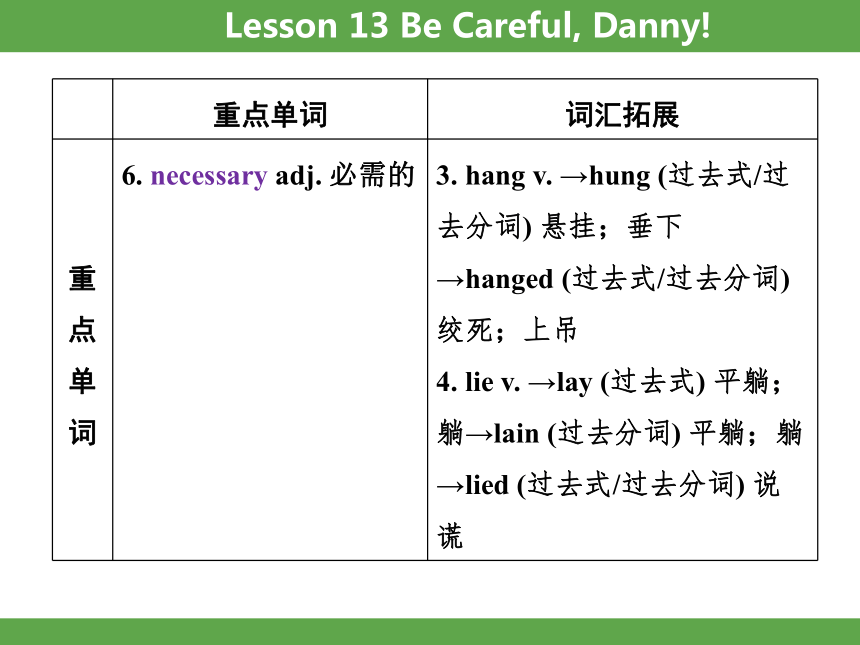
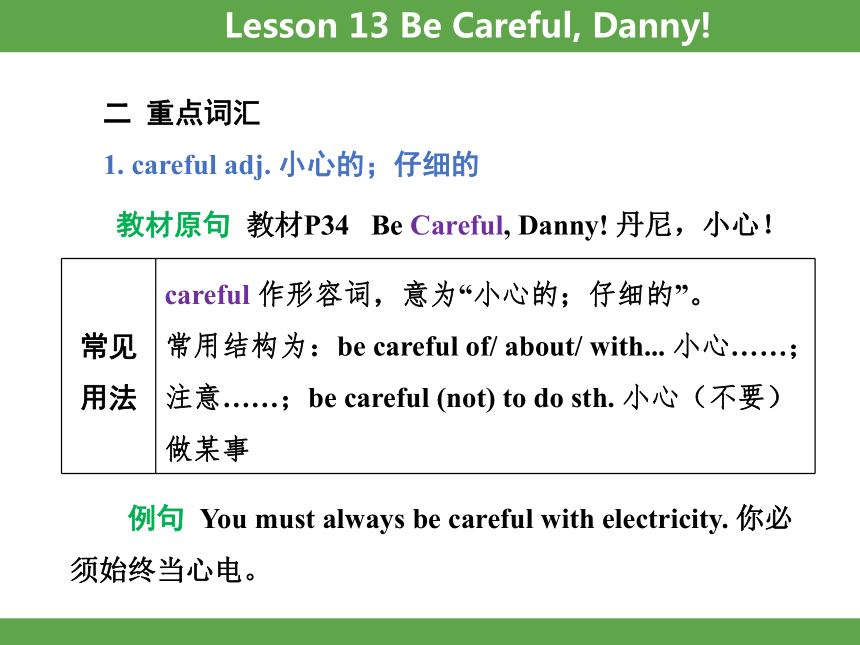
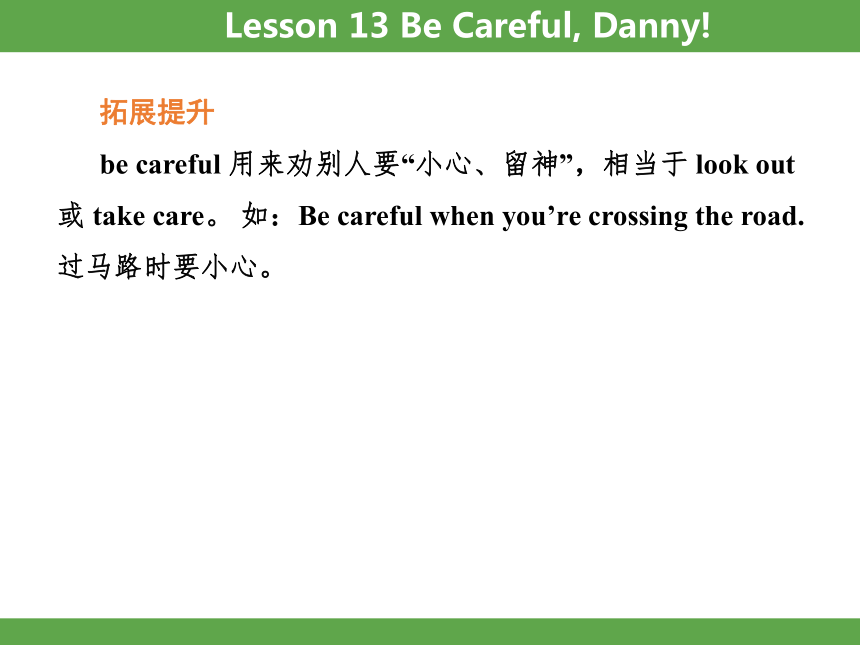
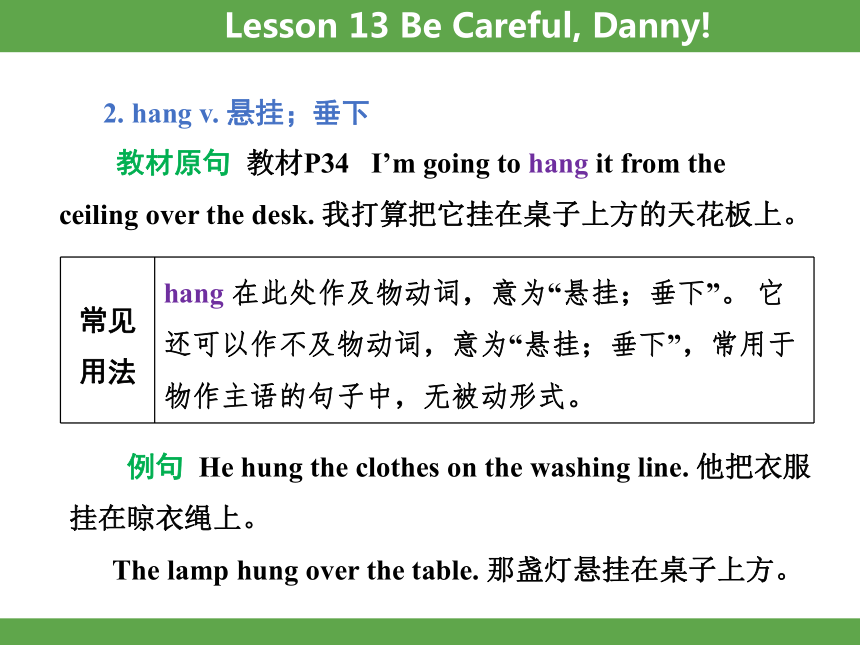
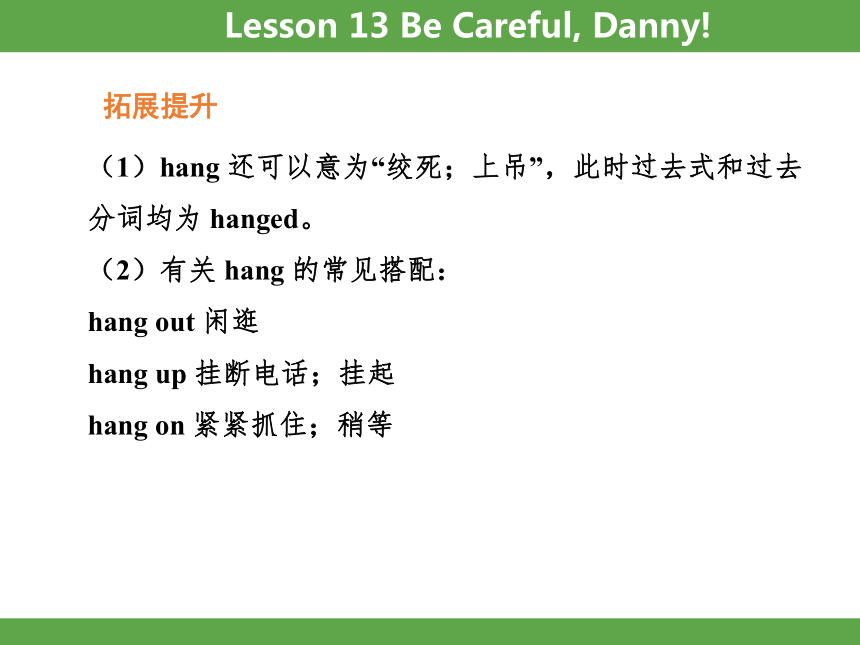
文档简介
(共100张PPT)
语
言
知识目
标
单元素养目标
词汇
话题
Safety(安全)
四会词
safety; careful; hang; lie; serious; necessary; accident; town; ugly;
shoulder; wound; expect; sudden; blood; knee; bleed; rock; stick;
stranger; careless; certain; themselves; salt; scissors; knife; heat; burn;earthquake; calm; object; rule; training
Unit 3 Safety
语
言
知识目
标
单元素养目标
词汇
非四
会词
decorate; ceiling; ambulance; reporter; roll; fault; icy; recover; helmet;wham; sharp; scary; goodness; prevent; baking; soda; poison; bathtub;slip; system; survival; branch
Unit 3 Safety
重点
短语
jump up; in time; run after; jump out;
all of a sudden; go down; so... that...; lie
down; take off; stick out of; put out;
stay calm; protect... from (doing)...;
pull over;keep an eye out for; bring down
语
言
知识目
标
单元素养目标
1. I don’t think my arm is broken.
2. Doctors say she can expect to return to school in about a week.
3. I felt so terrible that I lay down again.
4. Never leave small children alone in a bathtub.
5. Earthquakes usually come without warning.
6. He felt bad because he was careless.
7. You advised him to use a ladder, but he didn’t listen.
8. Don’t use water to put out kitchen fires.
9. If you see a fire, quickly move outdoors to an open area.
10. Be careful with scissors and knives!
重点
句型
Unit 3 Safety
语
言
知识目
标
单元素养目标
祈使句
语法
Unit 3 Safety
Unit 3 Safety
语言能力目标
单元素养目标
单词:掌握本单元重点单词的音、形、义、性、用
短语:掌握本单元重点短语并能熟练造句
句型:掌握本单元重点句型,并能就本单元话题
熟练应用
语篇:·阅读提醒和警示的短文,获取关键信息
·读懂有关安全题材方面的文章
·能就“安全”话题进行讨论
表达:·就安全与规则、安全与保护进行讨论
·就需要注意的安全问题进行写作
● 考点清单解读
一 单词背记及拓展
二 重点词汇
三 重点句式
Lesson 13 Be Careful, Danny!
一 单词背记及拓展
重点单词 词汇拓展
重 点 单 词 1. safety n. 安全;平安 2. careful adj. 小心的;仔细的 3. hang v. 悬挂;垂下 4. lie v. 平躺;躺 v. 说谎n. 谎言,谎话 5. serious adj. 严重的;严肃的 1. safety n. →safe (形容词) 安全的;平安的
2. careful adj. →care (名词/动词) 关心;照顾
→carefully (副词) 小心地;仔细地
→careless (反义词) 粗心的;疏忽的
Lesson 13 Be Careful, Danny!
重点单词 词汇拓展
重 点 单 词 6. necessary adj. 必需的 3. hang v. →hung (过去式/过去分词) 悬挂;垂下
→hanged (过去式/过去分词) 绞死;上吊
4. lie v. →lay (过去式) 平躺;躺→lain (过去分词) 平躺;躺
→lied (过去式/过去分词) 说谎
Lesson 13 Be Careful, Danny!
二 重点词汇
1. careful adj. 小心的;仔细的
教材原句 教材P34 Be Careful, Danny! 丹尼,小心!
常见用法 careful 作形容词,意为“小心的;仔细的”。
常用结构为:be careful of/ about/ with... 小心……;注意……;be careful (not) to do sth. 小心(不要)做某事
例句 You must always be careful with electricity. 你必须始终当心电。
Lesson 13 Be Careful, Danny!
拓展提升
be careful 用来劝别人要“小心、留神”,相当于 look out 或 take care。 如:Be careful when you’re crossing the road. 过马路时要小心。
Lesson 13 Be Careful, Danny!
2. hang v. 悬挂;垂下
教材原句 教材P34 I’m going to hang it from the ceiling over the desk. 我打算把它挂在桌子上方的天花板上。
常见用法 hang 在此处作及物动词,意为“悬挂;垂下”。 它还可以作不及物动词,意为“悬挂;垂下”,常用于物作主语的句子中,无被动形式。
例句 He hung the clothes on the washing line. 他把衣服挂在晾衣绳上。
The lamp hung over the table. 那盏灯悬挂在桌子上方。
Lesson 13 Be Careful, Danny!
拓展提升
(1)hang 还可以意为“绞死;上吊”,此时过去式和过去分词均为 hanged。
(2)有关 hang 的常见搭配:
hang out 闲逛
hang up 挂断电话;挂起
hang on 紧紧抓住;稍等
Lesson 13 Be Careful, Danny!
3. lie v. 平躺;躺 v. 说谎 n. 谎言,谎话
教材原句 教材P34 He sees Danny lying on the floor. 他看见丹尼躺在地上。
常见用法 (1)lie 作动词,意为“平躺;躺”,其过去式、过去分词分别为 lay,lain,现在分词为 lying。 常用搭配:lie down 躺下。
(2)lie 作动词,意为“说谎”,其过去式、过去分词均为 lied,现在分词为 lying。 常用搭配:lie to sb. 对某人说谎。
Lesson 13 Be Careful, Danny!
常见用法 (3)lie 作名词,意为“谎言,谎话”,为可数名词。 常用搭配:tell a lie/ tell lies 撒谎。
例句 The man lying on the ground lied that he saw a dragon in the sky. 躺在地上的那个人谎称他在天空中看到了一条龙。
Lesson 13 Be Careful, Danny!
拓展提升
lay 可用作动词使用,意为“产(卵);下(蛋);放置”,其过去式、过去分词均为 laid,现在分词为 laying。
图解妙记
Lesson 13 Be Careful, Danny!
4. serious adj. 严重的;严肃的
教材原句 教材P34 My tail hurts a little, but it’s not serious. 我的尾巴有点儿疼,但不严重。
常见用法 serious 是形容词,意为“严重的;严肃的”,在句中常作表语或定语。 副词为 seriously,比较级为 more serious,最高级为 most serious。
例句 Nobody realizes that it’s a serious problem. 没有人意识到这是个严重的问题。
Lesson 13 Be Careful, Danny!
拓展提升
(1)serious 作形容词,还可意为“认真的”。 常用搭配:be serious about sb./(doing) sth. 对某人/(做)某事是认真的。
(2)take sb./ sth. seriously 认真对待某人/某事。
Lesson 13 Be Careful, Danny!
三 重点句式
1. 否定疑问句
教材原句 教材P34 Isn’t it beautiful 难道它不漂亮吗?
句式 结构 本句是否定疑问句,用来表示说话人惊奇、反问、责难或失望等语气,意为“难道……不……吗? ”。 构成为:Be 动词/助动词/情态动词与 not 的缩写形式+主语+其他
例句 Can’t you see a dog 难道你没看见狗吗?
Didn’t you know 难道你不知道吗?
Lesson 13 Be Careful, Danny!
易错提示
一般疑问句的否定结构的答语在形式上与一般疑问句的答语一样,但翻译成汉语时,Yes 要译成“不”,No要译成“对,是的”。 如:
—Don’t you want to go fishing with us
你不想和我们一起去钓鱼吗?
—Yes, I do. 不,我想。
Lesson 13 Be Careful, Danny!
2. 否定前移
教材原句 教材P34 I don’t think my arm is broken. 我认为我的胳膊没有断。
句式 结构 当主句主语是 I 或者 we,think 后跟否定意义的宾语从句时,要将从句的否定转移到主句中,即否定前移。
例句 I don’t think you are right. 我认为你不对。
We don’t think they will win the game. 我们认为他们将不会赢得比赛。
Lesson 13 Be Careful, Danny!
拓展提升
与 think 用法类似的词还有 believe, suppose,imagine 等。
易错提示
否定前移句在翻译成汉语时,要把否定词还原到宾语从句中去。
Lesson 13 Be Careful, Danny!
● 考点清单解读
一 单词背记及拓展
二 重点词汇
三 重点句式
Lesson 14 Accidents Happen
一 单词背记及拓展
重点单词 词汇拓展
重 点 单 词 1. town n. 城镇 2. ugly adj. 丑陋的;难看的 3. shoulder n. 肩;肩膀 4. wound n. 伤;伤口 5. expect v. 期待;盼望 6. accident n. 事故;意外 1. ugly adj. →beautiful (反义词) 漂亮的;好看的
2. shoulder n. →shoulders (复数) 肩;肩膀
3. expect v. →expected (过去式/过去分词) 期待;盼望→expects (第三人称单数) 期待;盼望
Lesson 14 Accidents Happen
熟词生义
重点单词 wound 作名词时,还可以意为“伤害;痛苦”。
Lesson 14 Accidents Happen
二 重点词汇
1. expect v. 期待;盼望
教材原句 教材P36 Doctors say she can expect to return to school in about a week. 医生说她大约一周后有希望返回学校。
常见用法 expect 作动词时,意为“期待;盼望”。常用搭配:expect sth. 盼望/期待某物;expect (sb.) to do sth. 期望(某人)做某事;expect+that从句,期望/待……。
Lesson 14 Accidents Happen
例句 He expects us to go there on time.
他期望我们按时到那里。
The professor expected respect from his students.
教授期望得到学生的尊敬。
We expect that Tom will win first place in the speech contest.
我们期待汤姆会在演讲比赛中得第一名。
Lesson 14 Accidents Happen
易混辨析
expect, hope 和wish 的用法区别:
(1)expect 和 wish 后可接复合宾语,即 expect sb. to do sth.(期待某人做某事)/ wish sb. to dosth.(希望某人做某事)。
(2)hope 后不可接复合宾语。
Lesson 14 Accidents Happen
拓展提升
expectation名词,意为“期待;预料”。 如:
The more expectation, the more disappointment.
期望越大,失望就越大。
2. in time 及时
教材原句 教材P36 And the street was icy — the car couldn’t stop in time. 街上结冰了———汽车没能及时停下来。
常见用法 in time 意为“及时”,为固定短语,表示情况恰到好处。
例句 I hope you will arrive in time to attend the meeting. 我希望你能及时赶来参加这个会议。
Lesson 14 Accidents Happen
拓展提升
含有 time 的其他常见短语:
on time 按时;准时
at that time 在那时
from time to time 有时
at the same time 同时
all the time 一直
Lesson 14 Accidents Happen
三 重点句式
1. until 引导的时间状语从句
教材原句 教材P36 He stopped traffic on the road until the ambulance came. 他拦住了路上的车辆,直到救护车到达。
Lesson 14 Accidents Happen
常见用法 until 作连词,意为“直到……为止”,引导时间状语从句,相当于till。 位于句首时,通常用 until 而不能用 till。 含 until/ till 引导的时间状语从句的复合句具体用法如下:
(1)主句为肯定句,从句谓语动词通常为延续性动词。
(2)主句为否定句,主从句为 not... till/ until...结构。 主句谓语动词既可以是延续性动词,也可以是非延续性动词。
Lesson 14 Accidents Happen
例句 Passengers are required to remain seated until the plane comes to a full stop. 乘客们被要求在飞机没有完全停下前要坐在座位上。
You never really understand a person until you consider things from his point of view.
直到你从他的角度考虑问题,你才能真正理解一个人。
Lesson 14 Accidents Happen
易错提示
not... until...引导时间状语从句时的主从句时态问题:
(1)主句用一般将来时,until 引导的从句用一般现在时。 如:It’s raining too hard outside. We won’t leave until the rain stops.外面雨下得太大了。 直到雨停我们才会离开。
(2)主从句都用过去时态。 如:I didn’t understand my mum’s love until we had a long talk. 直到我们长谈,我才明白妈妈的爱。
Lesson 14 Accidents Happen
2. stop sb./ sth. from doing sth.的用法
教材原句 教材P36 wanted to stop her from running after the ball, but she didn’t hear me. 我想阻止她追那个球,但是她没有听见我的话。
常见用法 stop sb./ sth. from doing sth.意为“阻止某人/某物做某事”,句中的介词 from 可以省略。
例句 Do not let any difficulty stop you from trying, for you can never tell how close you may be to success. 不要让任何失败阻碍你尝试,因为你永远也不知道胜利离你有多近。
Lesson 14 Accidents Happen
拓展提升
同义短语为keep/ prevent sb./ sth. from doing sth.。 其中 prevent 后面的介词 from 可以省略,但 keep后不可以省略介词 from。
如:As we know, trees can prevent water from washing the earth away.
据我们所知, 树木可以防止水土流失。
Lesson 14 Accidents Happen
● 考点清单解读
一 单词背记及拓展
二 重点词汇
三 重点句式
Lesson 15 My Helmet Saved My Life!
一 单词背记及拓展
重点单词 词汇拓展
重 点 单 词 1. sudden n. & adj. 突然(的) 2. blood n. 血 3. knee n. 膝;膝盖;膝关节 4. rock n. 碎石;岩石 5. stick v. 插入;穿入 6. stranger n. 陌生人 1. sudden n. & adj. →suddenly (副词) 突然地
2. blood n. →bleed (动词) 流血;失血
3. knee n. →knees (复数) 膝;膝盖;膝关节
4. stick v. →stuck (过去式/过去分词) 插入;穿入
Lesson 15 My Helmet Saved My Life!
重点单词 词汇拓展
重 点 单 词 7. careless adj. 粗心的 8. bleed v. 流血;失血 5. stranger n. →strange (形容词) 奇怪的;陌生的
6. careless adj. →carelessly (副词) 粗心地;不注意地
→careful (反义词) 小心的;仔细的
Lesson 15 My Helmet Saved My Life!
熟词生义
重点单词 rock 作名词时,还可以意为“摇滚乐”。
Lesson 15 My Helmet Saved My Life!
二 重点词汇
1. take off 摘下;脱掉
教材原句 教材P38 As I lay there, I took off my helmet. 当我躺在那儿时,我摘下了我的头盔。
常见用法 take off 是由“动词+副词”构成的短语。 若宾语为人称代词,则应放在两词之间;若宾语为名词,则放在 off 前后均可。反义短语为 put on(穿上)。
Lesson 15 My Helmet Saved My Life!
看图 背例句
Lesson 15 My Helmet Saved My Life!
It was so hot that the boy took off his coat.
天气太热了, 这个男孩脱掉了他的外套。
拓展提升
take off 还可意为“(飞机)起飞”。
图解妙记
Lesson 15 My Helmet Saved My Life!
Hurry up! The plane is taking off soon. 快点! 飞机很快就要起飞了。
2. stick v. 插入;穿入
教材原句 教材P38 There was a sharp rock sticking out of it. 有一块尖锐的石头穿透了它(安全帽)。
常见用法 stick 作动词,意为“插入;穿入”。 stick 的过去式和过去分词为stuck。 常用搭配:stick... in/ into... 将……刺入……;stick out of从……伸出/探出。
Lesson 15 My Helmet Saved My Life!
看图 背例句
Lesson 15 My Helmet Saved My Life!
Stick these candles in the birthday cake. 将这些蜡烛插到生日蛋糕上。
拓展提升
stick to 意为“坚持;固守”,后面常接意见、原则、
计划、决定、诺言等。
图解妙记
stick 的常见含义
Lesson 15 My Helmet Saved My Life!
3. careless adj. 粗心的
教材原句 教材P38 She knew I was careless and did not always wear my helmet. 她知道我粗心,并不总是戴头盔。
常见用法 careless 作形容词,意为“粗心的;不小心的”,可以在句中作表语或定语。 常见用法:be careless about/ of/ with... 对……不关心/不在意;be careless to do sth. 做某事很粗心。
Lesson 15 My Helmet Saved My Life!
例句 You were careless to make such a mistake. = It was careless of you to make such a mistake. 你犯这样的错误真是粗心。
Lesson 15 My Helmet Saved My Life!
拓展提升
“名词 +less” 构成形容词。 后缀-less 的意思是“无……的,不能……”。 类似的词还有:
use+less → useless 无用的
help+less → helpless 无助的
home+less → homeless无家可归的
hope+less → hopeless 无望的
Lesson 15 My Helmet Saved My Life!
三 重点句式
1. There is something wrong with...的用法
教材原句 教材P38 “There’s something wrong with me,” I thought. 我想:“我受伤了。 ”
Lesson 15 My Helmet Saved My Life!
句式 结构 There is something wrong with...为固定句型,意为“……伤着了;……出毛病了”,相当于“Something is wrong with...”。
例句 There is something wrong with my car. = Something is wrong with my car. 我的车出毛病了。
拓展提升
否定形式为“There is nothing wrong with...” 或“There isn’t any_x0002_thing wrong with...”。 如:
There’s nothing wrong with my mother’s eyes. = There
isn’t anything wrong with my mother’s eyes.
我妈妈的眼睛没有毛病。
Lesson 15 My Helmet Saved My Life!
2. so... that...的用法
教材原句 教材P38 I felt so terrible that I lay down again. 我感觉如此糟糕,所以我又躺下了。
常见用法 so... that...意为“如此……以至于……”。 其中,so 后跟形容词或副词,that 引导结果状语从句。 常见用法如下:
so+形容词/副词+that 从句
so+形容词+a/ an+可数名词单数+that 从句
so many/ much/ few/ little (少)+名词+that 从句
Lesson 15 My Helmet Saved My Life!
例句 He speaks so fast that I can hardly understand him. 他说得那么快,以至于我几乎不能明白。
Lesson 15 My Helmet Saved My Life!
易错提示
such... that...意为“如此……以至于……”,such修 饰 名 词(短 语), that 引导结果状语从句。 如:
He is such a lovely boy that everyone loves him. 他是如此可爱的一个男孩,以至于每个人都喜欢他。
Lesson 15 My Helmet Saved My Life!
● 考点清单解读
一 单词背记及拓展
二 重点词汇
Lesson 16 How Safe Is Your Home
一 单词背记及拓展
重点单词 词汇拓展
重 点 单 词 1. certain adj. 某些;某个 2. themselves pron. 他(她、它)们自己 3. salt n. 食盐 4. scissors n. 剪刀 5. knife n. 刀 6. heat n. 高温;热;炉灶 v. 加热 1. certain adj. →certainly (副词) 肯定;当然
2. themselves pron. →they (主格) 他(她、它)们
→them (宾格) 他(她、它)们
3. knife n. →knives (复数) 刀
Lesson 16 How Safe Is Your Home
重点单词 词汇拓展
重 点 单 词 7. burn v. 烧伤;烫伤;燃烧 8. prevent v. 阻止;预防 4. heat v. →heated (过去式/过去分词) 加热
5. burn v. →burned/ burnt (过去式) 烧伤;烫伤;燃烧
→burned/ burnt (过去分词) 烧伤;烫伤;燃烧
→burning (现在分词) 烧伤;烫伤;燃烧
Lesson 16 How Safe Is Your Home
二 重点词汇
1. themselves pron. 他(她、它)们自己
教材原句 教材P40 Many people hurt themselves by falling off chairs. 许多人从椅子上掉下来摔伤了他们自己。
常见用法 themselves 为反身代词,意为“他(她、它)们自己”,在句中可作宾语、表语或同位语。 用作同位语时表强调。
Lesson 16 How Safe Is Your Home
例句 Success belongs to those who consider themselves to be winners.
成功属于那些认为自己是胜利者的人。
Their biggest enemy is themselves.
他们最大的敌人是他们自己。
Lesson 16 How Safe Is Your Home
拓展提升
含反身代词的常见词组:
(all) by oneself 独自,单独
enjoy oneself 玩得高兴
call oneself 自称
help oneself (to sth.)随便吃/喝……
teach oneself 自学
Lesson 16 How Safe Is Your Home
2. put out 扑灭
教材原句 教材P40 Don’t use water to put out kitchen fires. 不要用水扑灭厨房里的火。
常见用法 put out 是由“动词+副词”构成的短语,后接代词作宾语时,只能放在两词之间;后接名词作宾语时,放在 out 前后均可。
Lesson 16 How Safe Is Your Home
例句 With this kind of new machine, firemen can put out fires safely without risking their own lives. 有了这种新型机器, 消防员可以在不用冒生命危险的情况下安全地灭火。
Lesson 16 How Safe Is Your Home
拓展提升
put 的其他常见短语:
put away 收起来
put on 穿上;上演
put down 放下;写下
put off 推迟
put up 张贴;提出
Lesson 16 How Safe Is Your Home
3. fall off 从……上掉下来
教材原句 教材P40 Many people hurt themselves by falling off chairs. 许多人从椅子上掉下来摔伤了他们自己。
常见用法 fall off 意为“从……上掉下来”,相当于 fall/ drop down from。
Lesson 16 How Safe Is Your Home
例句 Tom fell off the tree and broke his leg. = Tom fell/ dropped down from the tree and broke his leg. 汤姆从树上掉下来,摔断了腿。
拓展提升
fall 的其他常见短语:
fall behind 落后
fall over 摔倒
fall on/ upon 落在……上
fall in love with... 爱上……
Lesson 16 How Safe Is Your Home
4. leave... alone 让……独自待着;把……单独留下
教材原句 教材P40 Never leave small children alone in a bathtub.永远不要把小孩子单独留在浴缸里(洗澡)。
常见用法 leave... alone 意为“让……独自待着;把……单独留下”,相当于leave... by oneself。 leave sth. alone 表示“不要碰某物”。
Lesson 16 How Safe Is Your Home
例句 Don’t leave a child alone in a room with an open fire. 不要把孩子单独留在有明火的房间里。
拓展提升
leave 的用法:
(1)离开。 leave for A 动身去 A 地;leave A for B 离开
A 地去 B 地。
(2)把……留在某处。 leave sb./ sth. at/ in/ on+地点,把
某人/某物留在……
Lesson 16 How Safe Is Your Home
● 考点清单解读
一 单词背记及拓展
二 重点词汇
Lesson 17 Staying Safe in an Earthquake
一 单词背记及拓展
重点单词 词汇拓展
重 点 单 词 1. earthquake n. 地震 2. object n. 物体;对象;目标 3. calm adj. 镇静的;沉着的 4. system n. 系统 5. survival n. 生存;存活;幸存 1. object n. →objects (复数) 物体;对象;目标
2. calm adj. →calmly (副词) 冷静地;镇静地
→calmer (比较级) 更镇静的;更沉着的
→calmest (最高级) 最镇静的;最沉着的
Lesson 17 Staying Safe in an Earthquake
词汇拓展
重点单词 3. survival n. →survive (动词) 幸免于难;存活
Lesson 17 Staying Safe in an Earthquake
二 重点词汇
1. calm adj. 镇静的;沉着的
教材原句 教材P42 Stay calm as the earth begins to shake and move. 当大地开始摇晃和移动时要保持镇静。
常见用法 calm 作形容词,意为“镇静的;沉着的”,常用搭配:stay/ keep calm 保持镇静。
Lesson 17 Staying Safe in an Earthquake
例句 We think everybody should be calm enough to express their needs. 我们认为每个人都应该冷静地表达自己的需求。
Lesson 17 Staying Safe in an Earthquake
拓展提升
calm 还可以作动词,意为“(使)镇静”,常用搭配:calm down(使)平静下来。 如:
Calm down and think twice while facing choices. 面对选择时要冷静下来,三思而后行。
2. keep an eye out for 密切注意;提防;警觉
教材原句 教材P42 Keep an eye out for things that can fall on you. 密切注意可能落到你身上的物体。
常见用法 keep an eye out for 意为“密切注意;提防;警觉”。for 是介词,后面可接名词、代词或动名词形式。
Lesson 17 Staying Safe in an Earthquake
例句 It’s always better to keep an eye out for your pet dog while you are going for a walk. 当你们外出散步时密切注意你的宠物狗总是好的。
Lesson 17 Staying Safe in an Earthquake
拓展提升
keep 的其他常见短语:
keep away from 远离……
keep an eye on 照看;注视
keep in touch with...和……保持联系
● 考点清单解读
一 单词背记及拓展
二 重点词汇
三 重点句式
四 重点语法
Lesson 18 Never Catch a Dinosaur
一 单词背记及拓展
重点单词 词汇拓展
重 点 单 词 1. rule n. 规则;规章 2. training n. 训练;培养 3. branch n. 树枝 1. rule n. →rules (复数) 规则;规章
→ruler (名词) 统治者;尺子
2. training n. →train (动词) 训练;培养
3. branch n. →branches (复数) 树枝
Lesson 18 Never Catch a Dinosaur
二 重点词汇
1. rule n. 规则;规章
教材原句 教材P44 I like your new rule. 我喜欢你的新规则。
常见用法 rule 为可数名词,意为“规则;规章”。 常用短语:traffic rules 交通规则;follow/ obey the rule 遵守规则;break a rule 违反规则;make a rule 制定规则。
Lesson 18 Never Catch a Dinosaur
例句 We should study the new traffic rules and learn how to protect ourselves. 我们应该学习新的交通规则,学会如何保护我们自己。
Lesson 18 Never Catch a Dinosaur
拓展提升
rule 作名词时,还可意为“习惯;常规”;作动词时,意为“支配,统治”。
如:He ruled the country for half a century.
他统治了这个国家半个世纪。
Lesson 18 Never Catch a Dinosaur
2. advise v. 建议;劝告
教材原句 教材P44 You advised him to use a ladder, but he didn’t listen. 你建议他使用一架梯子,但他不听。
常见用法 advise 为及物动词,意为“建议;劝告”,主要用法如下:
advise sb. (not) to do sth. 建议某人(不)做某事
advise doing sth. 建议做某事
advise sb. against doing sth. 建议某人不要做某事
Lesson 18 Never Catch a Dinosaur
例句 I advise you not to go out alone at night.
我建议你晚上不要独自外出。
I advise waiting them to go hiking together.
我建议等他们一起去远足。
Lesson 18 Never Catch a Dinosaur
拓展提升
advise 的名词形式为 advice,意为“建议;劝告”,是不可数名词,可用 some,much, a piece of, pieces of 修饰。 搭配:ask sb. for advice 向某人征求建议。 如:
To finish the task, we need some advice rather than useless complaints.
为了完成任务,我们需要一些建议,而不是无用的抱怨。
Lesson 18 Never Catch a Dinosaur
三 重点句式
1.“比较级+and+比较级”的用法
教材原句 教材P44 She watched me climb higher and higher. 她看着我爬得越来越高。
句式 结构 higher and higher 意为“越来越高”。在英语中,“比较级+and+比较级”或“more and more+多音节的形容词或副词”表示“越来越……”。
Lesson 18 Never Catch a Dinosaur
例句 Our country is becoming more and more beautiful. 我们的国家正在变得越来越美丽。
Lesson 18 Never Catch a Dinosaur
拓展提升
“the + 比 较 级 ,the+比较级”意为“越……,就越……”。 如:The more a person reads, the wiser he will be. 一个人读书越多,他就会变得越聪明。
Lesson 18 Never Catch a Dinosaur
2.“It takes/ took sb.+时间+to do sth.”句型
教材原句 教材P44 It took me three months to recover. 我花了三个月的时间康复。
句式 结构 “It takes/ took sb.+时间+to do sth.”句型表示“做某事花费某人多长时间”,还可以表示为“Doing sth. takes sb.+时间.”。
Lesson 18 Never Catch a Dinosaur
例句 It took me two weeks to get ready for the sports meeting. 我花了两个星期准备运动会。
拓展提升
其他表示“花费”的句型:
①sb. spends/ spent time/ money doing sth. 某人花费时间/金钱做某事;② sb . spends / spent time / money on sth. 某人在某事上花费时间或金钱;③sb. pays/ paid money for sth. 某人付钱买某物。
Lesson 18 Never Catch a Dinosaur
四 重点语法
祈 使 句
教材原句 教材P34 Let me get the ladder for you. 让我把梯子给你。
教材P40 Use baking soda or salt instead. 用小苏打或盐代替。
教材P40 Don’t use water to put out kitchen fires. 不要用水扑灭厨房里的火。
教材P40 Never use electricity in the shower or bathtub. 不要在淋浴间或在浴缸里使用电。
Lesson 18 Never Catch a Dinosaur
常见用法 祈使句通常用来表达请求、命令、警告、禁止等。 祈使句因对象(即主语)通常是第二人称,所以通常省略主语而以动词原形开头。 句末常用句号或感叹号。
Lesson 18 Never Catch a Dinosaur
(一)祈使句的肯定形式
1. Do 型:动词原形+其他成分.
例句 Go and wash your hands. 去洗一洗你的手。
2. Be 型:Be+表语+其他成分.
例句 Be careful next time! 下次小心!
3. Let 型:Let+宾语+动词原形+其他成分.
Lesson 18 Never Catch a Dinosaur
例句 Let me read the letter for you. 让我来给你读这封信吧。
(二)祈使句的否定形式
1. Do 型和 Be 型的祈使句的否定形式通常是在句首加 don’t,有时加 never。
例句 Don’t be nervous! 不要紧张!
Never give up! 决不放弃!
2. Let 型的祈使句的否定形式是:Let+宾语+not+动词原形+其他成分,也可以在 let 前加 don’t。
Lesson 18 Never Catch a Dinosaur
例句 Let’s not say anything about it. 这件事咱们谁也别说了。Don’t let them go. 不要让他们走。
3.“No+名词 / 动名词”结构的祈使句通常用于公共场所的提示语,表示禁止。
例句 No photos! 禁止拍照! No smoking! 禁止吸烟!
(三)祈使句的应答
祈使句表示将来发生的动作,所以回答时一般用 will 或 won’t。 回答肯定形式的祈使句通常用 will,回答否定形式的祈使句通常用 won’t。
Lesson 18 Never Catch a Dinosaur
例句 —Don’t be late again. 不要再迟到了。
—Sorry, I won’t. 抱歉,我不会了。
拓展提升
1. 祈使 句 常 在句前或句末加上 please,构成“Please...” 或“..., please.” 句式,以使语气更加缓和或客气,但有时前面也可以加 do,以加强语气。 如:
Please stand up.= Stand up, please.请站起来.
Do let him go. 一定让他去。
2. 祈使句的特殊形式
(1)名词/代词+副词Hands up! 举起手来!
(2)名词/形容词/副词
Lesson 18 Never Catch a Dinosaur
Attention! 注意!
Careful! 小心!
Quickly! 快点!
(3)副词+with 短语
Away with them! 把他们带走!
3.“祈使句+and/ or+陈述句”结构可转换为含有 if 引导的条件状语从句的主从复合句。 and 或 or 后面的陈述句常用一般将来时。 如:
Lesson 18 Never Catch a Dinosaur
Hurry up, or you won’t catch the bus.
= If you don’t hurry up, you won’t catch the bus.
快点,否则你会赶不上公交车的。
Lesson 18 Never Catch a Dinosaur
语篇考法精讲
跨学科试题解题技巧
典例剖析
语篇考法精讲
[中考新考法·跨数学函数关系]
Which one can show the relationship between time and the temperature in a car
语篇考法精讲
[解析]分析题干并关注框内关键词“Outside Temperature 27℃”并结合数学知识可知,随着时间的增长,车内的温度会逐渐升高,排除A 项; 且图中给出的时间是从第 20 分钟开始的,排除 B、D 选项。 故选 C。
[答案] C
语篇考法精讲
考法说明
跨学科综合题不是单纯地考查英语知识,而是要求同学们在理解英语文章及题目的同时,综合运用多学科基础知识和背景知识来解题,因而具有考查综合知识的特点。 解答这类试题时,需要学生掌握好各学科基础知识,以此来拓宽知识面,能够看懂英语表达的多学科知识内容。
语篇考法精讲
阅读理解对跨学科综合题的考查涉及:跨语文学科类(如著名诗人代表作、 古诗翻译)、跨数学学科类(如数字计算)、跨地理学科类(如解读地图或路线图)、跨物理学科类(如力的平衡实验)等。因此,我们需要把英语学习和其他学科知识相结合。
语篇考法精讲
技巧点拨
解答此类试题时,需要学生分析文本、理解文段细节信息,分析题干,找出关键词,再充分利用所学的各科知识,进行分析、推理、判断,从而得出正确答案。
语
言
知识目
标
单元素养目标
词汇
话题
Safety(安全)
四会词
safety; careful; hang; lie; serious; necessary; accident; town; ugly;
shoulder; wound; expect; sudden; blood; knee; bleed; rock; stick;
stranger; careless; certain; themselves; salt; scissors; knife; heat; burn;earthquake; calm; object; rule; training
Unit 3 Safety
语
言
知识目
标
单元素养目标
词汇
非四
会词
decorate; ceiling; ambulance; reporter; roll; fault; icy; recover; helmet;wham; sharp; scary; goodness; prevent; baking; soda; poison; bathtub;slip; system; survival; branch
Unit 3 Safety
重点
短语
jump up; in time; run after; jump out;
all of a sudden; go down; so... that...; lie
down; take off; stick out of; put out;
stay calm; protect... from (doing)...;
pull over;keep an eye out for; bring down
语
言
知识目
标
单元素养目标
1. I don’t think my arm is broken.
2. Doctors say she can expect to return to school in about a week.
3. I felt so terrible that I lay down again.
4. Never leave small children alone in a bathtub.
5. Earthquakes usually come without warning.
6. He felt bad because he was careless.
7. You advised him to use a ladder, but he didn’t listen.
8. Don’t use water to put out kitchen fires.
9. If you see a fire, quickly move outdoors to an open area.
10. Be careful with scissors and knives!
重点
句型
Unit 3 Safety
语
言
知识目
标
单元素养目标
祈使句
语法
Unit 3 Safety
Unit 3 Safety
语言能力目标
单元素养目标
单词:掌握本单元重点单词的音、形、义、性、用
短语:掌握本单元重点短语并能熟练造句
句型:掌握本单元重点句型,并能就本单元话题
熟练应用
语篇:·阅读提醒和警示的短文,获取关键信息
·读懂有关安全题材方面的文章
·能就“安全”话题进行讨论
表达:·就安全与规则、安全与保护进行讨论
·就需要注意的安全问题进行写作
● 考点清单解读
一 单词背记及拓展
二 重点词汇
三 重点句式
Lesson 13 Be Careful, Danny!
一 单词背记及拓展
重点单词 词汇拓展
重 点 单 词 1. safety n. 安全;平安 2. careful adj. 小心的;仔细的 3. hang v. 悬挂;垂下 4. lie v. 平躺;躺 v. 说谎n. 谎言,谎话 5. serious adj. 严重的;严肃的 1. safety n. →safe (形容词) 安全的;平安的
2. careful adj. →care (名词/动词) 关心;照顾
→carefully (副词) 小心地;仔细地
→careless (反义词) 粗心的;疏忽的
Lesson 13 Be Careful, Danny!
重点单词 词汇拓展
重 点 单 词 6. necessary adj. 必需的 3. hang v. →hung (过去式/过去分词) 悬挂;垂下
→hanged (过去式/过去分词) 绞死;上吊
4. lie v. →lay (过去式) 平躺;躺→lain (过去分词) 平躺;躺
→lied (过去式/过去分词) 说谎
Lesson 13 Be Careful, Danny!
二 重点词汇
1. careful adj. 小心的;仔细的
教材原句 教材P34 Be Careful, Danny! 丹尼,小心!
常见用法 careful 作形容词,意为“小心的;仔细的”。
常用结构为:be careful of/ about/ with... 小心……;注意……;be careful (not) to do sth. 小心(不要)做某事
例句 You must always be careful with electricity. 你必须始终当心电。
Lesson 13 Be Careful, Danny!
拓展提升
be careful 用来劝别人要“小心、留神”,相当于 look out 或 take care。 如:Be careful when you’re crossing the road. 过马路时要小心。
Lesson 13 Be Careful, Danny!
2. hang v. 悬挂;垂下
教材原句 教材P34 I’m going to hang it from the ceiling over the desk. 我打算把它挂在桌子上方的天花板上。
常见用法 hang 在此处作及物动词,意为“悬挂;垂下”。 它还可以作不及物动词,意为“悬挂;垂下”,常用于物作主语的句子中,无被动形式。
例句 He hung the clothes on the washing line. 他把衣服挂在晾衣绳上。
The lamp hung over the table. 那盏灯悬挂在桌子上方。
Lesson 13 Be Careful, Danny!
拓展提升
(1)hang 还可以意为“绞死;上吊”,此时过去式和过去分词均为 hanged。
(2)有关 hang 的常见搭配:
hang out 闲逛
hang up 挂断电话;挂起
hang on 紧紧抓住;稍等
Lesson 13 Be Careful, Danny!
3. lie v. 平躺;躺 v. 说谎 n. 谎言,谎话
教材原句 教材P34 He sees Danny lying on the floor. 他看见丹尼躺在地上。
常见用法 (1)lie 作动词,意为“平躺;躺”,其过去式、过去分词分别为 lay,lain,现在分词为 lying。 常用搭配:lie down 躺下。
(2)lie 作动词,意为“说谎”,其过去式、过去分词均为 lied,现在分词为 lying。 常用搭配:lie to sb. 对某人说谎。
Lesson 13 Be Careful, Danny!
常见用法 (3)lie 作名词,意为“谎言,谎话”,为可数名词。 常用搭配:tell a lie/ tell lies 撒谎。
例句 The man lying on the ground lied that he saw a dragon in the sky. 躺在地上的那个人谎称他在天空中看到了一条龙。
Lesson 13 Be Careful, Danny!
拓展提升
lay 可用作动词使用,意为“产(卵);下(蛋);放置”,其过去式、过去分词均为 laid,现在分词为 laying。
图解妙记
Lesson 13 Be Careful, Danny!
4. serious adj. 严重的;严肃的
教材原句 教材P34 My tail hurts a little, but it’s not serious. 我的尾巴有点儿疼,但不严重。
常见用法 serious 是形容词,意为“严重的;严肃的”,在句中常作表语或定语。 副词为 seriously,比较级为 more serious,最高级为 most serious。
例句 Nobody realizes that it’s a serious problem. 没有人意识到这是个严重的问题。
Lesson 13 Be Careful, Danny!
拓展提升
(1)serious 作形容词,还可意为“认真的”。 常用搭配:be serious about sb./(doing) sth. 对某人/(做)某事是认真的。
(2)take sb./ sth. seriously 认真对待某人/某事。
Lesson 13 Be Careful, Danny!
三 重点句式
1. 否定疑问句
教材原句 教材P34 Isn’t it beautiful 难道它不漂亮吗?
句式 结构 本句是否定疑问句,用来表示说话人惊奇、反问、责难或失望等语气,意为“难道……不……吗? ”。 构成为:Be 动词/助动词/情态动词与 not 的缩写形式+主语+其他
例句 Can’t you see a dog 难道你没看见狗吗?
Didn’t you know 难道你不知道吗?
Lesson 13 Be Careful, Danny!
易错提示
一般疑问句的否定结构的答语在形式上与一般疑问句的答语一样,但翻译成汉语时,Yes 要译成“不”,No要译成“对,是的”。 如:
—Don’t you want to go fishing with us
你不想和我们一起去钓鱼吗?
—Yes, I do. 不,我想。
Lesson 13 Be Careful, Danny!
2. 否定前移
教材原句 教材P34 I don’t think my arm is broken. 我认为我的胳膊没有断。
句式 结构 当主句主语是 I 或者 we,think 后跟否定意义的宾语从句时,要将从句的否定转移到主句中,即否定前移。
例句 I don’t think you are right. 我认为你不对。
We don’t think they will win the game. 我们认为他们将不会赢得比赛。
Lesson 13 Be Careful, Danny!
拓展提升
与 think 用法类似的词还有 believe, suppose,imagine 等。
易错提示
否定前移句在翻译成汉语时,要把否定词还原到宾语从句中去。
Lesson 13 Be Careful, Danny!
● 考点清单解读
一 单词背记及拓展
二 重点词汇
三 重点句式
Lesson 14 Accidents Happen
一 单词背记及拓展
重点单词 词汇拓展
重 点 单 词 1. town n. 城镇 2. ugly adj. 丑陋的;难看的 3. shoulder n. 肩;肩膀 4. wound n. 伤;伤口 5. expect v. 期待;盼望 6. accident n. 事故;意外 1. ugly adj. →beautiful (反义词) 漂亮的;好看的
2. shoulder n. →shoulders (复数) 肩;肩膀
3. expect v. →expected (过去式/过去分词) 期待;盼望→expects (第三人称单数) 期待;盼望
Lesson 14 Accidents Happen
熟词生义
重点单词 wound 作名词时,还可以意为“伤害;痛苦”。
Lesson 14 Accidents Happen
二 重点词汇
1. expect v. 期待;盼望
教材原句 教材P36 Doctors say she can expect to return to school in about a week. 医生说她大约一周后有希望返回学校。
常见用法 expect 作动词时,意为“期待;盼望”。常用搭配:expect sth. 盼望/期待某物;expect (sb.) to do sth. 期望(某人)做某事;expect+that从句,期望/待……。
Lesson 14 Accidents Happen
例句 He expects us to go there on time.
他期望我们按时到那里。
The professor expected respect from his students.
教授期望得到学生的尊敬。
We expect that Tom will win first place in the speech contest.
我们期待汤姆会在演讲比赛中得第一名。
Lesson 14 Accidents Happen
易混辨析
expect, hope 和wish 的用法区别:
(1)expect 和 wish 后可接复合宾语,即 expect sb. to do sth.(期待某人做某事)/ wish sb. to dosth.(希望某人做某事)。
(2)hope 后不可接复合宾语。
Lesson 14 Accidents Happen
拓展提升
expectation名词,意为“期待;预料”。 如:
The more expectation, the more disappointment.
期望越大,失望就越大。
2. in time 及时
教材原句 教材P36 And the street was icy — the car couldn’t stop in time. 街上结冰了———汽车没能及时停下来。
常见用法 in time 意为“及时”,为固定短语,表示情况恰到好处。
例句 I hope you will arrive in time to attend the meeting. 我希望你能及时赶来参加这个会议。
Lesson 14 Accidents Happen
拓展提升
含有 time 的其他常见短语:
on time 按时;准时
at that time 在那时
from time to time 有时
at the same time 同时
all the time 一直
Lesson 14 Accidents Happen
三 重点句式
1. until 引导的时间状语从句
教材原句 教材P36 He stopped traffic on the road until the ambulance came. 他拦住了路上的车辆,直到救护车到达。
Lesson 14 Accidents Happen
常见用法 until 作连词,意为“直到……为止”,引导时间状语从句,相当于till。 位于句首时,通常用 until 而不能用 till。 含 until/ till 引导的时间状语从句的复合句具体用法如下:
(1)主句为肯定句,从句谓语动词通常为延续性动词。
(2)主句为否定句,主从句为 not... till/ until...结构。 主句谓语动词既可以是延续性动词,也可以是非延续性动词。
Lesson 14 Accidents Happen
例句 Passengers are required to remain seated until the plane comes to a full stop. 乘客们被要求在飞机没有完全停下前要坐在座位上。
You never really understand a person until you consider things from his point of view.
直到你从他的角度考虑问题,你才能真正理解一个人。
Lesson 14 Accidents Happen
易错提示
not... until...引导时间状语从句时的主从句时态问题:
(1)主句用一般将来时,until 引导的从句用一般现在时。 如:It’s raining too hard outside. We won’t leave until the rain stops.外面雨下得太大了。 直到雨停我们才会离开。
(2)主从句都用过去时态。 如:I didn’t understand my mum’s love until we had a long talk. 直到我们长谈,我才明白妈妈的爱。
Lesson 14 Accidents Happen
2. stop sb./ sth. from doing sth.的用法
教材原句 教材P36 wanted to stop her from running after the ball, but she didn’t hear me. 我想阻止她追那个球,但是她没有听见我的话。
常见用法 stop sb./ sth. from doing sth.意为“阻止某人/某物做某事”,句中的介词 from 可以省略。
例句 Do not let any difficulty stop you from trying, for you can never tell how close you may be to success. 不要让任何失败阻碍你尝试,因为你永远也不知道胜利离你有多近。
Lesson 14 Accidents Happen
拓展提升
同义短语为keep/ prevent sb./ sth. from doing sth.。 其中 prevent 后面的介词 from 可以省略,但 keep后不可以省略介词 from。
如:As we know, trees can prevent water from washing the earth away.
据我们所知, 树木可以防止水土流失。
Lesson 14 Accidents Happen
● 考点清单解读
一 单词背记及拓展
二 重点词汇
三 重点句式
Lesson 15 My Helmet Saved My Life!
一 单词背记及拓展
重点单词 词汇拓展
重 点 单 词 1. sudden n. & adj. 突然(的) 2. blood n. 血 3. knee n. 膝;膝盖;膝关节 4. rock n. 碎石;岩石 5. stick v. 插入;穿入 6. stranger n. 陌生人 1. sudden n. & adj. →suddenly (副词) 突然地
2. blood n. →bleed (动词) 流血;失血
3. knee n. →knees (复数) 膝;膝盖;膝关节
4. stick v. →stuck (过去式/过去分词) 插入;穿入
Lesson 15 My Helmet Saved My Life!
重点单词 词汇拓展
重 点 单 词 7. careless adj. 粗心的 8. bleed v. 流血;失血 5. stranger n. →strange (形容词) 奇怪的;陌生的
6. careless adj. →carelessly (副词) 粗心地;不注意地
→careful (反义词) 小心的;仔细的
Lesson 15 My Helmet Saved My Life!
熟词生义
重点单词 rock 作名词时,还可以意为“摇滚乐”。
Lesson 15 My Helmet Saved My Life!
二 重点词汇
1. take off 摘下;脱掉
教材原句 教材P38 As I lay there, I took off my helmet. 当我躺在那儿时,我摘下了我的头盔。
常见用法 take off 是由“动词+副词”构成的短语。 若宾语为人称代词,则应放在两词之间;若宾语为名词,则放在 off 前后均可。反义短语为 put on(穿上)。
Lesson 15 My Helmet Saved My Life!
看图 背例句
Lesson 15 My Helmet Saved My Life!
It was so hot that the boy took off his coat.
天气太热了, 这个男孩脱掉了他的外套。
拓展提升
take off 还可意为“(飞机)起飞”。
图解妙记
Lesson 15 My Helmet Saved My Life!
Hurry up! The plane is taking off soon. 快点! 飞机很快就要起飞了。
2. stick v. 插入;穿入
教材原句 教材P38 There was a sharp rock sticking out of it. 有一块尖锐的石头穿透了它(安全帽)。
常见用法 stick 作动词,意为“插入;穿入”。 stick 的过去式和过去分词为stuck。 常用搭配:stick... in/ into... 将……刺入……;stick out of从……伸出/探出。
Lesson 15 My Helmet Saved My Life!
看图 背例句
Lesson 15 My Helmet Saved My Life!
Stick these candles in the birthday cake. 将这些蜡烛插到生日蛋糕上。
拓展提升
stick to 意为“坚持;固守”,后面常接意见、原则、
计划、决定、诺言等。
图解妙记
stick 的常见含义
Lesson 15 My Helmet Saved My Life!
3. careless adj. 粗心的
教材原句 教材P38 She knew I was careless and did not always wear my helmet. 她知道我粗心,并不总是戴头盔。
常见用法 careless 作形容词,意为“粗心的;不小心的”,可以在句中作表语或定语。 常见用法:be careless about/ of/ with... 对……不关心/不在意;be careless to do sth. 做某事很粗心。
Lesson 15 My Helmet Saved My Life!
例句 You were careless to make such a mistake. = It was careless of you to make such a mistake. 你犯这样的错误真是粗心。
Lesson 15 My Helmet Saved My Life!
拓展提升
“名词 +less” 构成形容词。 后缀-less 的意思是“无……的,不能……”。 类似的词还有:
use+less → useless 无用的
help+less → helpless 无助的
home+less → homeless无家可归的
hope+less → hopeless 无望的
Lesson 15 My Helmet Saved My Life!
三 重点句式
1. There is something wrong with...的用法
教材原句 教材P38 “There’s something wrong with me,” I thought. 我想:“我受伤了。 ”
Lesson 15 My Helmet Saved My Life!
句式 结构 There is something wrong with...为固定句型,意为“……伤着了;……出毛病了”,相当于“Something is wrong with...”。
例句 There is something wrong with my car. = Something is wrong with my car. 我的车出毛病了。
拓展提升
否定形式为“There is nothing wrong with...” 或“There isn’t any_x0002_thing wrong with...”。 如:
There’s nothing wrong with my mother’s eyes. = There
isn’t anything wrong with my mother’s eyes.
我妈妈的眼睛没有毛病。
Lesson 15 My Helmet Saved My Life!
2. so... that...的用法
教材原句 教材P38 I felt so terrible that I lay down again. 我感觉如此糟糕,所以我又躺下了。
常见用法 so... that...意为“如此……以至于……”。 其中,so 后跟形容词或副词,that 引导结果状语从句。 常见用法如下:
so+形容词/副词+that 从句
so+形容词+a/ an+可数名词单数+that 从句
so many/ much/ few/ little (少)+名词+that 从句
Lesson 15 My Helmet Saved My Life!
例句 He speaks so fast that I can hardly understand him. 他说得那么快,以至于我几乎不能明白。
Lesson 15 My Helmet Saved My Life!
易错提示
such... that...意为“如此……以至于……”,such修 饰 名 词(短 语), that 引导结果状语从句。 如:
He is such a lovely boy that everyone loves him. 他是如此可爱的一个男孩,以至于每个人都喜欢他。
Lesson 15 My Helmet Saved My Life!
● 考点清单解读
一 单词背记及拓展
二 重点词汇
Lesson 16 How Safe Is Your Home
一 单词背记及拓展
重点单词 词汇拓展
重 点 单 词 1. certain adj. 某些;某个 2. themselves pron. 他(她、它)们自己 3. salt n. 食盐 4. scissors n. 剪刀 5. knife n. 刀 6. heat n. 高温;热;炉灶 v. 加热 1. certain adj. →certainly (副词) 肯定;当然
2. themselves pron. →they (主格) 他(她、它)们
→them (宾格) 他(她、它)们
3. knife n. →knives (复数) 刀
Lesson 16 How Safe Is Your Home
重点单词 词汇拓展
重 点 单 词 7. burn v. 烧伤;烫伤;燃烧 8. prevent v. 阻止;预防 4. heat v. →heated (过去式/过去分词) 加热
5. burn v. →burned/ burnt (过去式) 烧伤;烫伤;燃烧
→burned/ burnt (过去分词) 烧伤;烫伤;燃烧
→burning (现在分词) 烧伤;烫伤;燃烧
Lesson 16 How Safe Is Your Home
二 重点词汇
1. themselves pron. 他(她、它)们自己
教材原句 教材P40 Many people hurt themselves by falling off chairs. 许多人从椅子上掉下来摔伤了他们自己。
常见用法 themselves 为反身代词,意为“他(她、它)们自己”,在句中可作宾语、表语或同位语。 用作同位语时表强调。
Lesson 16 How Safe Is Your Home
例句 Success belongs to those who consider themselves to be winners.
成功属于那些认为自己是胜利者的人。
Their biggest enemy is themselves.
他们最大的敌人是他们自己。
Lesson 16 How Safe Is Your Home
拓展提升
含反身代词的常见词组:
(all) by oneself 独自,单独
enjoy oneself 玩得高兴
call oneself 自称
help oneself (to sth.)随便吃/喝……
teach oneself 自学
Lesson 16 How Safe Is Your Home
2. put out 扑灭
教材原句 教材P40 Don’t use water to put out kitchen fires. 不要用水扑灭厨房里的火。
常见用法 put out 是由“动词+副词”构成的短语,后接代词作宾语时,只能放在两词之间;后接名词作宾语时,放在 out 前后均可。
Lesson 16 How Safe Is Your Home
例句 With this kind of new machine, firemen can put out fires safely without risking their own lives. 有了这种新型机器, 消防员可以在不用冒生命危险的情况下安全地灭火。
Lesson 16 How Safe Is Your Home
拓展提升
put 的其他常见短语:
put away 收起来
put on 穿上;上演
put down 放下;写下
put off 推迟
put up 张贴;提出
Lesson 16 How Safe Is Your Home
3. fall off 从……上掉下来
教材原句 教材P40 Many people hurt themselves by falling off chairs. 许多人从椅子上掉下来摔伤了他们自己。
常见用法 fall off 意为“从……上掉下来”,相当于 fall/ drop down from。
Lesson 16 How Safe Is Your Home
例句 Tom fell off the tree and broke his leg. = Tom fell/ dropped down from the tree and broke his leg. 汤姆从树上掉下来,摔断了腿。
拓展提升
fall 的其他常见短语:
fall behind 落后
fall over 摔倒
fall on/ upon 落在……上
fall in love with... 爱上……
Lesson 16 How Safe Is Your Home
4. leave... alone 让……独自待着;把……单独留下
教材原句 教材P40 Never leave small children alone in a bathtub.永远不要把小孩子单独留在浴缸里(洗澡)。
常见用法 leave... alone 意为“让……独自待着;把……单独留下”,相当于leave... by oneself。 leave sth. alone 表示“不要碰某物”。
Lesson 16 How Safe Is Your Home
例句 Don’t leave a child alone in a room with an open fire. 不要把孩子单独留在有明火的房间里。
拓展提升
leave 的用法:
(1)离开。 leave for A 动身去 A 地;leave A for B 离开
A 地去 B 地。
(2)把……留在某处。 leave sb./ sth. at/ in/ on+地点,把
某人/某物留在……
Lesson 16 How Safe Is Your Home
● 考点清单解读
一 单词背记及拓展
二 重点词汇
Lesson 17 Staying Safe in an Earthquake
一 单词背记及拓展
重点单词 词汇拓展
重 点 单 词 1. earthquake n. 地震 2. object n. 物体;对象;目标 3. calm adj. 镇静的;沉着的 4. system n. 系统 5. survival n. 生存;存活;幸存 1. object n. →objects (复数) 物体;对象;目标
2. calm adj. →calmly (副词) 冷静地;镇静地
→calmer (比较级) 更镇静的;更沉着的
→calmest (最高级) 最镇静的;最沉着的
Lesson 17 Staying Safe in an Earthquake
词汇拓展
重点单词 3. survival n. →survive (动词) 幸免于难;存活
Lesson 17 Staying Safe in an Earthquake
二 重点词汇
1. calm adj. 镇静的;沉着的
教材原句 教材P42 Stay calm as the earth begins to shake and move. 当大地开始摇晃和移动时要保持镇静。
常见用法 calm 作形容词,意为“镇静的;沉着的”,常用搭配:stay/ keep calm 保持镇静。
Lesson 17 Staying Safe in an Earthquake
例句 We think everybody should be calm enough to express their needs. 我们认为每个人都应该冷静地表达自己的需求。
Lesson 17 Staying Safe in an Earthquake
拓展提升
calm 还可以作动词,意为“(使)镇静”,常用搭配:calm down(使)平静下来。 如:
Calm down and think twice while facing choices. 面对选择时要冷静下来,三思而后行。
2. keep an eye out for 密切注意;提防;警觉
教材原句 教材P42 Keep an eye out for things that can fall on you. 密切注意可能落到你身上的物体。
常见用法 keep an eye out for 意为“密切注意;提防;警觉”。for 是介词,后面可接名词、代词或动名词形式。
Lesson 17 Staying Safe in an Earthquake
例句 It’s always better to keep an eye out for your pet dog while you are going for a walk. 当你们外出散步时密切注意你的宠物狗总是好的。
Lesson 17 Staying Safe in an Earthquake
拓展提升
keep 的其他常见短语:
keep away from 远离……
keep an eye on 照看;注视
keep in touch with...和……保持联系
● 考点清单解读
一 单词背记及拓展
二 重点词汇
三 重点句式
四 重点语法
Lesson 18 Never Catch a Dinosaur
一 单词背记及拓展
重点单词 词汇拓展
重 点 单 词 1. rule n. 规则;规章 2. training n. 训练;培养 3. branch n. 树枝 1. rule n. →rules (复数) 规则;规章
→ruler (名词) 统治者;尺子
2. training n. →train (动词) 训练;培养
3. branch n. →branches (复数) 树枝
Lesson 18 Never Catch a Dinosaur
二 重点词汇
1. rule n. 规则;规章
教材原句 教材P44 I like your new rule. 我喜欢你的新规则。
常见用法 rule 为可数名词,意为“规则;规章”。 常用短语:traffic rules 交通规则;follow/ obey the rule 遵守规则;break a rule 违反规则;make a rule 制定规则。
Lesson 18 Never Catch a Dinosaur
例句 We should study the new traffic rules and learn how to protect ourselves. 我们应该学习新的交通规则,学会如何保护我们自己。
Lesson 18 Never Catch a Dinosaur
拓展提升
rule 作名词时,还可意为“习惯;常规”;作动词时,意为“支配,统治”。
如:He ruled the country for half a century.
他统治了这个国家半个世纪。
Lesson 18 Never Catch a Dinosaur
2. advise v. 建议;劝告
教材原句 教材P44 You advised him to use a ladder, but he didn’t listen. 你建议他使用一架梯子,但他不听。
常见用法 advise 为及物动词,意为“建议;劝告”,主要用法如下:
advise sb. (not) to do sth. 建议某人(不)做某事
advise doing sth. 建议做某事
advise sb. against doing sth. 建议某人不要做某事
Lesson 18 Never Catch a Dinosaur
例句 I advise you not to go out alone at night.
我建议你晚上不要独自外出。
I advise waiting them to go hiking together.
我建议等他们一起去远足。
Lesson 18 Never Catch a Dinosaur
拓展提升
advise 的名词形式为 advice,意为“建议;劝告”,是不可数名词,可用 some,much, a piece of, pieces of 修饰。 搭配:ask sb. for advice 向某人征求建议。 如:
To finish the task, we need some advice rather than useless complaints.
为了完成任务,我们需要一些建议,而不是无用的抱怨。
Lesson 18 Never Catch a Dinosaur
三 重点句式
1.“比较级+and+比较级”的用法
教材原句 教材P44 She watched me climb higher and higher. 她看着我爬得越来越高。
句式 结构 higher and higher 意为“越来越高”。在英语中,“比较级+and+比较级”或“more and more+多音节的形容词或副词”表示“越来越……”。
Lesson 18 Never Catch a Dinosaur
例句 Our country is becoming more and more beautiful. 我们的国家正在变得越来越美丽。
Lesson 18 Never Catch a Dinosaur
拓展提升
“the + 比 较 级 ,the+比较级”意为“越……,就越……”。 如:The more a person reads, the wiser he will be. 一个人读书越多,他就会变得越聪明。
Lesson 18 Never Catch a Dinosaur
2.“It takes/ took sb.+时间+to do sth.”句型
教材原句 教材P44 It took me three months to recover. 我花了三个月的时间康复。
句式 结构 “It takes/ took sb.+时间+to do sth.”句型表示“做某事花费某人多长时间”,还可以表示为“Doing sth. takes sb.+时间.”。
Lesson 18 Never Catch a Dinosaur
例句 It took me two weeks to get ready for the sports meeting. 我花了两个星期准备运动会。
拓展提升
其他表示“花费”的句型:
①sb. spends/ spent time/ money doing sth. 某人花费时间/金钱做某事;② sb . spends / spent time / money on sth. 某人在某事上花费时间或金钱;③sb. pays/ paid money for sth. 某人付钱买某物。
Lesson 18 Never Catch a Dinosaur
四 重点语法
祈 使 句
教材原句 教材P34 Let me get the ladder for you. 让我把梯子给你。
教材P40 Use baking soda or salt instead. 用小苏打或盐代替。
教材P40 Don’t use water to put out kitchen fires. 不要用水扑灭厨房里的火。
教材P40 Never use electricity in the shower or bathtub. 不要在淋浴间或在浴缸里使用电。
Lesson 18 Never Catch a Dinosaur
常见用法 祈使句通常用来表达请求、命令、警告、禁止等。 祈使句因对象(即主语)通常是第二人称,所以通常省略主语而以动词原形开头。 句末常用句号或感叹号。
Lesson 18 Never Catch a Dinosaur
(一)祈使句的肯定形式
1. Do 型:动词原形+其他成分.
例句 Go and wash your hands. 去洗一洗你的手。
2. Be 型:Be+表语+其他成分.
例句 Be careful next time! 下次小心!
3. Let 型:Let+宾语+动词原形+其他成分.
Lesson 18 Never Catch a Dinosaur
例句 Let me read the letter for you. 让我来给你读这封信吧。
(二)祈使句的否定形式
1. Do 型和 Be 型的祈使句的否定形式通常是在句首加 don’t,有时加 never。
例句 Don’t be nervous! 不要紧张!
Never give up! 决不放弃!
2. Let 型的祈使句的否定形式是:Let+宾语+not+动词原形+其他成分,也可以在 let 前加 don’t。
Lesson 18 Never Catch a Dinosaur
例句 Let’s not say anything about it. 这件事咱们谁也别说了。Don’t let them go. 不要让他们走。
3.“No+名词 / 动名词”结构的祈使句通常用于公共场所的提示语,表示禁止。
例句 No photos! 禁止拍照! No smoking! 禁止吸烟!
(三)祈使句的应答
祈使句表示将来发生的动作,所以回答时一般用 will 或 won’t。 回答肯定形式的祈使句通常用 will,回答否定形式的祈使句通常用 won’t。
Lesson 18 Never Catch a Dinosaur
例句 —Don’t be late again. 不要再迟到了。
—Sorry, I won’t. 抱歉,我不会了。
拓展提升
1. 祈使 句 常 在句前或句末加上 please,构成“Please...” 或“..., please.” 句式,以使语气更加缓和或客气,但有时前面也可以加 do,以加强语气。 如:
Please stand up.= Stand up, please.请站起来.
Do let him go. 一定让他去。
2. 祈使句的特殊形式
(1)名词/代词+副词Hands up! 举起手来!
(2)名词/形容词/副词
Lesson 18 Never Catch a Dinosaur
Attention! 注意!
Careful! 小心!
Quickly! 快点!
(3)副词+with 短语
Away with them! 把他们带走!
3.“祈使句+and/ or+陈述句”结构可转换为含有 if 引导的条件状语从句的主从复合句。 and 或 or 后面的陈述句常用一般将来时。 如:
Lesson 18 Never Catch a Dinosaur
Hurry up, or you won’t catch the bus.
= If you don’t hurry up, you won’t catch the bus.
快点,否则你会赶不上公交车的。
Lesson 18 Never Catch a Dinosaur
语篇考法精讲
跨学科试题解题技巧
典例剖析
语篇考法精讲
[中考新考法·跨数学函数关系]
Which one can show the relationship between time and the temperature in a car
语篇考法精讲
[解析]分析题干并关注框内关键词“Outside Temperature 27℃”并结合数学知识可知,随着时间的增长,车内的温度会逐渐升高,排除A 项; 且图中给出的时间是从第 20 分钟开始的,排除 B、D 选项。 故选 C。
[答案] C
语篇考法精讲
考法说明
跨学科综合题不是单纯地考查英语知识,而是要求同学们在理解英语文章及题目的同时,综合运用多学科基础知识和背景知识来解题,因而具有考查综合知识的特点。 解答这类试题时,需要学生掌握好各学科基础知识,以此来拓宽知识面,能够看懂英语表达的多学科知识内容。
语篇考法精讲
阅读理解对跨学科综合题的考查涉及:跨语文学科类(如著名诗人代表作、 古诗翻译)、跨数学学科类(如数字计算)、跨地理学科类(如解读地图或路线图)、跨物理学科类(如力的平衡实验)等。因此,我们需要把英语学习和其他学科知识相结合。
语篇考法精讲
技巧点拨
解答此类试题时,需要学生分析文本、理解文段细节信息,分析题干,找出关键词,再充分利用所学的各科知识,进行分析、推理、判断,从而得出正确答案。
同课章节目录
- Unit 1 Stay Healthy
- Lesson 1 What's Wrong,Danny?
- Lesson 2 A Visit to the Dentist
- Lesson 3 Good Food, Good Health
- Lesson 4 Don't Smoke, Please!
- Lesson 5 Jane's Lucky Life
- Lesson 6 Stay Away from the Hospital
- Unit Review
- Unit 2 Great People
- Lesson 7 What Is the Meaning of Lift?
- Lesson 8 A Universe of Thought
- Lesson 9 China's Most Famous "Farmer"
- Lesson 10 Touch the World
- Lesson 11 To China, with Love
- Lesson 12 Guess My Hero!
- Unit Review
- Unit 3 Safety
- Lesson 13 Be Careful,Danny!
- Lesson 14 Accidents Happen
- Lesson 15 My Helmet Saved My Life!
- Lesson 16 How Safe Is Your Home?
- Lesson 17 Staying Safe in an Earthquake
- Lesson 18 Never Catch a Dinosaur
- Unit Review
- Unit 4 Stories and poems
- Lesson 19 A Story or a Poem?
- Lesson 20 Say It in Five
- Lesson 21 The Fable of the Woodcutte
- Lesson 22 The Giant(Ⅰ)
- Lesson 23 The Giant(Ⅱ)
- Lesson 24 Writing a Poem
- Unit Review
- Unit 5 Look into Science
- Lesson 25 Let's Do an Experiment!
- Lesson 26 Keep the Candle Burning
- Lesson 27 Planet Danny
- Lesson 28 The Study of Living Things
- Lesson 29 DNA—The Story of You
- Lesson 30 Science Affects Us
- Unit Review
- Unit 6 Movies and Theate
- Lesson 31 A movie or a Play
- Lesson 32 Moving Pictures
- Lesson 33 The Fisherman and the Goldfish(Ⅰ)
- Lesson 34 The Fisherman and the Goldfish(Ⅱ)
- Lesson 35 Theatres Are Fun!
- Lesson 36 Making Plays Is Fun
- Unit Review
